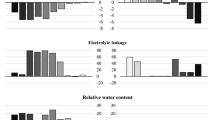Abstract
The relationship between the severity of natural freezing and frost damage (FFD) and the observed growth recovery and field production of Superior potatoes (Solanum tuberosum L.) was investigated under screen house conditions. Potato plants were damaged by accidental freezing and frost during the early phase of shoot growth, 40 days after planting in highland summer crop areas in Korea. The observations of FFD were classified visually into “severe” (>75%), “moderate” (50%), “mild” (<25%), and “no FFD”, based on the percentage of the area of the shoots which was damaged. The early vegetative growth recovery, in terms of groundcover, was reduced as the level of FFD increased. At 28 days after a freezing and frost damage (DAFF), the potato plants with mild or no symptoms had produced more groundcover than the plants with moderate or severe symptoms. At 35 DAFF, groundcover was the same across all levels of severity, at nearly 100%. Despite the slower canopy development, plants with FFD achieved a higher fresh shoot weight and total chlorophyll content, whereas physiological growth indices such as photosynthetic rate and stomatal conductance of leaves were not different among levels of FFD at 60 DAFF. The number of lateral stems and days to tuberization increased significantly as the level of FFD increased; however, the harvest index, the number of tubers per plant, and seed tuber production were all reduced in plants with severe FFD. In addition, the tubers from plants with severe FFD had an increased ratio of length to width and 40% more tuber eyes than tubers from undamaged plants. The elongated tubers also showed an increase in cell division, demonstrated by higher numbers of cells in the cortical zones. The aforementioned measurements were obtained from natural event and led to a deduction that Superior has a capacity to recover from FFD, unless the plants were severely damaged (>75%) early in the season.




Similar content being viewed by others
References
Beresford BC (1967) Effect of simulated hail damage on yield and quality of potatoes. Am Potato J 44:347–354
Boydston RA, Seymour MD, Brown CR, Alva AK (2006) Freezing behavior of potato (Solanum tuberosum) tubers in soil. Am J Potato Res 83:305–315
Brown PH (2007) The canon of potato science: 37. Stolonization, tuber induction and tuberization. Potato Res 50:363–365
Chang SC (1973) Compounding of Luft’s epon embedding medium for use in electron microscopy with reference to anhydride: epoxide ratio adjustment. Mikroskopie 29:337–342
Chang DC, Park CS, Kim SY, Kim SJ, Lee YB (2008) Physiological growth responses by nutrient interruption in aeroponically grown potatoes. Am J Potato Res 85:315–323
Chang DC, Hur OS, Park CS, Kim SY (2011) Field performance, yield components and nitrogen utilization efficiency of potato plants grown from hydroponic small tubers. Hortic Environ Biotech 52:369–375
Dorange G, Pennec ML (1989) Ultrastructural characteristics of spermatogenesis in Pecten maximus (Mollusca: Bivalvia). Invert Reprod Dev 15:109–117
Gardner FP, Pearce RB, Mitchell RL (1985) Physiology of crop plants. Iowa State Univ, Ames, Iowa, pp 66–67
Goodwin PB (1967) The control and branch growth on potato tubers: I. Anatomy of buds in relation to dormancy and correlative inhibition. J Exp Bot 18:78–86
Greaves JA, Wilson JM (1987) Assessment of the frost sensitivity of wild and cultivated potato species by chlorophyll fluorescence analysis. Potato Res 30:381–395
Hooker WJ (1981) Compendium of potato diseases. Amer. Phytopath. Soc, St. Paul, Minnesota, pp 8–10
Ignacio I, Domeno I, Muro J (2011) Effect of defoliation by simulated hail damage on yield of potato cultivars with different maturity performed in Spain. Am J Potato Res 88:82–90
KMA (2010) http://web.kma.go.kr/eng/index.jsp
Li PH, Huner NAP, Toivio-Kinnucan M, Chen HH, Palta JP (1981) Potato freezing injury and survival, and their relationships to other stress. Am Potato J 58:15–29
Milthorpe FL (1963) Some aspects of plant growth. In: Ivins JD, Milthorpe FL (eds) The growth of the potato. Butterworths, London, pp 3–16
Pavek MJ, Thornton RE (2009) Planting depth influences potato plant morphology and economic value. Am J Potato Res 86:56–67
Plaisted PH (1957) Growth of the potato tuber. Plant Physiol 32:445–453
Raviv M, Blom TJ (2001) The effect of water availability and quality on photosynthesis and productivity of soilless-grown cut roses. Sci Hortic 88:257–276
Rich AE (1950) The effect of various defoliants on potato vines and tubers in Washington, 1948. Am Potato J 27:87–92
Rich AE (1983) Noninfectious diseases. Potato diseases. Academic, New York, pp 154–157
Ross RW, Rowe PR (1965) Frost resistance among the Solanum species in the IR-1 potato collection. Am Potato J 42:177–185
Slater JW (1963) Mechanisms of tuber initiation. In: Ivins JD, Milthorpe FL (eds) The growth of the potato. Butterworths, London, pp 114–115
Stern KR (1994) Metabolism in plants. Introductory plant biology. Wm. C. Brown Communications, Iowa, pp 144–153
Sundbom E, Strand M, Hallgren JE (1982) Temperature-induced fluorescence changes: a screening method for frost tolerance of potato (Solanum sp). Plant Physiol 70:1299–1302
Vos J, Groenwold J (1989) Characteristics of photosynthesis and conductance of potato canopies and the effects of cultivar and transient drought. Field Crop Res 20:237–250
Wellik WJ, Slosser JE, Kirby RD (1981) Effects of simulated insect defoliation on potatoes. Am Potato J 58:627–632
Wille MJ, Kleinkopf GE (1992) Effect of simulated hail damage on yield and quality of russet burbank potatoes. Am Potato J 69:705–714
Acknowledgments
The authors of this study would like to thank the Gangwon Potato Seed Distribution Center for making available the potato fields with damage from freezing and frost. A grateful acknowledgement should also be given to Deok Hyun Cho and Hyun Jin Kim for their data collection. Financial support for this study was provided by the RDA-HARC potato research program (project no. PJ006364201010).
Author information
Authors and Affiliations
Corresponding author
Rights and permissions
About this article
Cite this article
Chang, D.C., Sohn, H.B., Cho, J.H. et al. Freezing and Frost Damage of Potato Plants: a Case Study on Growth Recovery, Yield Response, and Quality Changes. Potato Res. 57, 99–110 (2014). https://doi.org/10.1007/s11540-014-9253-5
Received:
Accepted:
Published:
Issue Date:
DOI: https://doi.org/10.1007/s11540-014-9253-5




